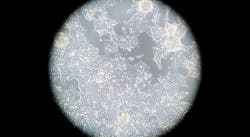The cell and gene therapy (CGT) market has grown remarkably over the last three years, driven by the promise of personalized medicine. Currently valued at $4.99 billion, the market is expected to grow to over $36 billion by 2027.
Whether treating patients with modified cells or modifying their genomes, the continued growth of the sector is dependent on reliable treatments that work. Unfortunately, residual host cell DNA is an insidious contaminant that can cancel out the therapeutic benefit of these treatments.
A common form of this contamination is residual DNA from human embryonic kidney-derived epithelial (HEK293) cells, which can render a treatment unsafe for patients. Therefore, improving detection methods to eliminate and prevent host cell contamination is critical to the success of these therapies moving forward.
A byproduct of working with cell lines
HEK293 cells are one of the most used cell lines in CGT manufacturing. They act as living factories, producing viral vectors that deliver the final therapeutic product. CGTs made using these cell factories often contain residual traces of their DNA, which can have severe consequences for manufacturers, such as increased regulatory hurdles and lost product batches that cost precious time and money to replace. For patients, this means a delay in treatment. Moreover, immortal cell lines like HEK293 may pass on tumorigenic or retroviral sequences to patients. These can cause severe immune reactions or oncogenesis contrary to the therapy's intended benefits.
When manufacturing CGTs, removing all host cell DNA is virtually impossible. Recognizing this threat to patient safety, the U.S. FDA has provided guidance that CGTs should contain no more than ten nanograms of residual host cell DNA per dose, sized at less than 200 base pairs.
Common approaches fall short
Scientists often use two techniques to assess CGT products: quantitative PCR (qPCR) technology to detect the presence of residual DNA and bioanalyzer technology to determine its size. However, both methods have limitations that raise concerns for those seeking to meet regulatory guidelines.
qPCR assays must be run alongside a manually diluted standard curve, reducing reproducibility and sensitivity. Moreover, qPCR assays are sensitive to PCR inhibitors, so technicians must perform DNA extraction before each assay. This lengthy, labor-intensive process introduces the further potential for inaccurate results that may reduce product quality and consistency and undermine product safety.
Bioanalyzer technology measures the length of DNA fragments in a sample; however, it can't assess DNA larger than seven kilobases. Nor does it identify where the contamination originated — a major CAR T-cell production issue. These limitations leave manufacturers needing more information about the residual host cell DNA their product contains.
The future of residual DNA detection
To ensure the safety of CGT products and adhere to regulatory guidelines, scientists now turn to droplet digital PCR (ddPCR) to accurately determine the quantity and size of residual host cell DNA.
By design, the ddPCR technology produces absolute quantification of nucleic acid molecules and highly reproducible results. A typical assay randomly distributes individual DNA molecules among ~20,000 droplets. After undergoing a standard PCR reaction, droplets containing the target sequence fluoresce. These are counted by a droplet reader and interpreted using Poisson statistics to count the number of DNA molecules in the original sample — no standard curve is needed. The workflow is efficient, sensitive, and precise, detecting target sequences down to 0.1 pg/µL; additionally, it uses an extraction-free, easy to use protocol which works with a broad range of sample types.
Because HEK293 cell lines are ubiquitous in CGT manufacturing, ddPCR kits are available to check for residual HEK293 DNA with exceptional specificity and reproducibility across a broad range of sample types. Additional ddPCR kits can distinguish whether HEK293 residual DNA is smaller or larger than 200 base pairs with high specificity, low cross-reactivity, and low false positive rates, allowing manufacturers to determine whether their product contains only small DNA fragments that fall within FDA guidelines.
Overall, these accurate, sensitive ddPCR solutions enable scientists to detect residual host cell DNA from their CGT products. Moreover, ddPCR approaches save time while producing high-quality data that meets regulatory standards. With a keen eye toward product purification and quality control testing, biomanufacturers can deliver robust and reliable CGT that transform patient lives.
